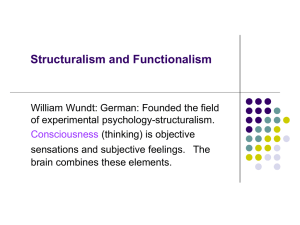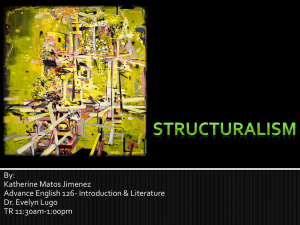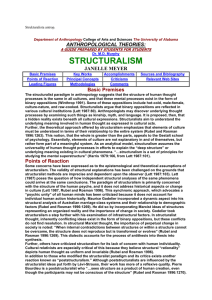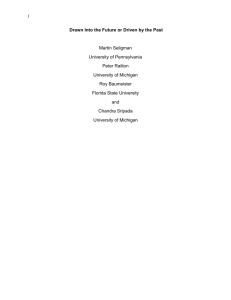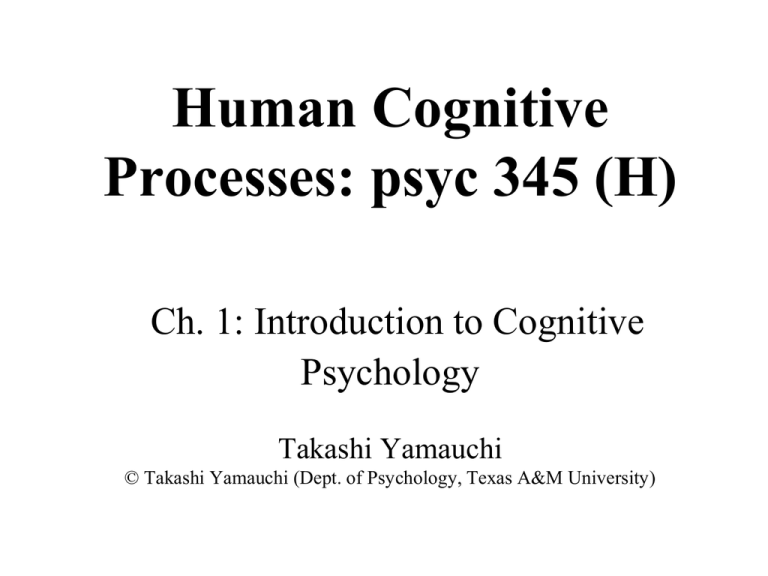
Human Cognitive
Processes: psyc 345 (H)
Ch. 1: Introduction to Cognitive
Psychology
Takashi Yamauchi
© Takashi Yamauchi (Dept. of Psychology, Texas A&M University)
What are we going to study?
– Human cognitive processes
• What is it?
– It is about human cognition
– = thinking
• Cognitive Psychology
– = The study of thinking
Studying the mind
• This definition is potentially misleading.
• Why?
Thinking
• Let’s list typical examples of thinking
– Solving a problem in a calculus class.
– Writing a philosophical essay in a creative writing class
– Trying to figure out a solution in a chemistry class
– Figuring out how to fix a car
Thinking
• Thinking (cognition) is everywhere
• It affects a lot more than you think.
Examples
• I used to starve myself to fit into my skinny jeans. I thought that thin
was everything, and I was losing everything to be thin. For years,
anorexia and bulimia stole my hopes and dreams. It almost took my
life….. My eating disorder was about low self-esteem, constant selfcriticism, and painful, unrelenting perfectionism.
– (Jenni Schaefer is a singer/songwriter, speaker, and the author of Life
Without Ed: How One Woman Declared Independence from Her Eating
Disorder and How You Can Too. This is an excerpt taken from the
website of National Eating Disoders Association)
Phobia
• A phobia (from Greek: φόβος, phobos, "fear"), is
an irrational, intense, persistent fear of certain
situations, activities, things, or persons.
• The main symptom of this disorder is the
excessive, unreasonable desire to avoid the feared
subject. When the fear is beyond one's control, or
if the fear is interfering with daily life, then a
diagnosis under one of the anxiety disorders can
be made.
– Wikipedia
Cognitive therapy
• Aaron T. Beck
– http://www.beckinstitute.org/Library/InfoManage/Guide.a
sp?FolderID=200&SessionID={D1EC9939-CD7F-4075A293-E50ECBB031D9}
Thinking
Step 1: Thought
+
Step 2: Action
=
SUCCESS
•
http://www.naphill.org/
•
We human beings are the only
creatures on earth who have the
capacity for belief. …. When you
set goals for yourself, make sure
they are based on doing the right
thing for your family, your friends,
your employees, and yourself.
•
When others see that you are fair
and just in your dealings with
them and that you are a generous,
principled person, they will move
heaven and earth for you.
Some Hindu proverb (from an unknown source)
• If you change your thinking, you change your
attitude.
• If you change your attitude, you change your
action.
• If you change your action, you change your habit.
• If you change your habit, you change your
personality.
• If you change your personality, you change your
destiny.
• If you change your destiny, you change your life.
Finally, everything we know of
starts with thinking
Think?
•
•
•
•
•
•
•
•
Perceiving – how do we see & hear?
Attending – how do we focus our attention?
Memory – How do we remember things?
Knowledge – How do we acquire new
knowledge?
Language – How do we communicate?
Reason – How do we reason?
Solving problems – How do we solve problems?
Decision making – How do we make decisions?
A brief history of cognitive
psychology
• “A brief history of Modern Psychology”
• By Ludy T. Benjamin
• Presidential Professor of Teaching Excellence,
TAMU
• http://people.tamu.edu/~l-benjamin/
Physiology
• Hermann von Helmholtz (1821-1894)
– German physician, physicist,
– Visual perception, physiological psychology
• Wilhelm Maximilian Wund (1832-1920)
– German physiologist
– Structuralism
• Gustav Fechner (1801-1889)
– Trained physicist
– German experimental psychologist
– psychophysics
American Psychology
• G. Stanley Hall (1844-1924)
• William James (1842-1910)
• James McKeen Cattel (1860-1944)
Wund
• The goal of psychology discover
– “the facts of consciousness”
• How do you study consciousness?
– Every conscious experience consists of
• the content of the experience and
• the process that makes the content available to the
experiencing individual.
• His psychology is about studying this
process and is called structuralism.
sound
process
experience
Psychology:
Study of the experience
of the experiencing
person
How did he do that?
• Identify all basic components of
consciousness (e.g., sensation)
• examine the way they are organized.
• This approach is called “Structuralism”
Structuralism (continued)
• Structuralism is about identifying the
structure of consciousness by
– 1. finding its basic elements
– 2. figuring out how they are organized
– 3. understanding why they are organized in a
particular manner given a conscious experience.
Method: Introspection
• Experimental self-observation (Introspection)
• Attention to the phenomenon and making a record
of the phenomenon.
– Train an observer
– The observer is presented with some stimulus briefly
(e.g., presenting a series of souns one by one)
– The observer gives an account of his / her mental
experience
Functionalism
• Wund’s students
– G. Stanley Hall
• Studied philosophy with W. James at Harvard
• Went to Leipzig in Germany and attended some
lectures by Wund
• Later established the first psychology laboratory at
Johns Hopkins
– McKeen Cattelle
• The first doctoral student of psychology
• Found laboratories at Univ. of Pennsylvania and at
Columbia.
Functionalism
• try to understand the utility of
consciousness
– What is it for?
– How did it come to be?
• How come we have “consciousness” in the way we
have now?
• Individual differences, and what create
differences
• Functionalist psychology
– Measured individual differences
• intelligence, IQ tests, child development, sex
differences, personality, motivation,…
– Studied practical applications
• Learning, abnormal behavior, business psychology,
educational psychology,…
• Structuralism vs. Functionalism
• S: What are the basic elements of consciousness and
how are they organized / structured?
• F: What leads people to feel and act in the way they
do?
Example
• Learning:
– Structuralism:
• Identify the basic elements underlying human
learning, and how they are organized (how do the
mental processes of learning work?).
– Functionalism:
• Find out why person A is a better learner than
person B.
Behaviorism
• The antithesis of structuralism
• Structuralism
– Method self-observation, introspection
Behaviorism (1920’s-1950’s)
• Focus on
– The relation between observable behavior and
environmental events / stimuli
• Learning is to establish
– Associations between stimuli and responses
Where did this idea come from?
• Ivan Pavlov (1849-1936)
• Classical conditioning
– Food salivate
– Food + bell salivate
– Bell salivate
http://www.youtube.com/watch?v=
hhqumfpxuzI&feature=related
Radical Behaviorism
• All forms of human behavior can be explained by
a process that links a stimulus and a response.
• Skinner’s operant conditioning
– Rewards and punishments as we encounter in the
environment shape our behavior.
• Skinner box (0:51)
– http://www.youtube.com/watch?v=PQtDTdDr8vs
What’s wrong with this idea?
• Is learning all about forming stimulusresponse associations ?
Emergence of Cognitive Psychology
• The antithesis of behaviorism
• Noam Chomsky’s Language Acquisition
Device (LAD)
How do children acquire language?
– Behaviorist:
• Imitate adults and establish stimulus and response
connections.
• “Dog”
Noam Chomsky’s criticism
Productivity and systematicity of language
• Children can produce new sentences they have
never heard before.
• Almost anyone can produce an infinite number of
sentences.
• http://www.chomsky.info/
Guinness Book of World Records:
• The longest English sentence ever written: 1300 words in
William Faulkner’s novel “Absalom, Absalom!
– “They both bore it as though deliberate flagellant exaltation…..”
– Faulkner wrote, “They both bore it as though deliberate flagellant
exaltation…..”
– Takashi said that Faulkner wrote, “They both bore it as though
deliberate flagellant exaltation…..”
– John said, who cares Takashi said that Faulkner wrote, “They both
bore it as though deliberate flagellant exaltation…..”
(Taken from S. Pinker’s “Language Instinct”)
• LAD (Language acquisition device)
– Language learning is not just linking a stimulus
and a response, but
– there should be some internal structure geared
for the acquisition of language.
Behaviorism vs. cognitivism
Cognitive Revolution
• The development of the computer
– Information processing and the Universal Turing machine
• AI (artificial intelligence)
– H. Simon and Newell’s Physical Symbol Hypothesis
• Neural science
– Neural network, cognitive neuroscience and brain imaging
• Linguistics
– Noam Chomsky’s Universal Grammar
• Information theory
– Shannon’s information theory
A major assumption in cognitive
psychology
• Information processing
– Cognition as computation
• Information processing
– Cognition as computation
A flow diagram of
an early computer
A flow diagram of
Broadbent’s
attention model


